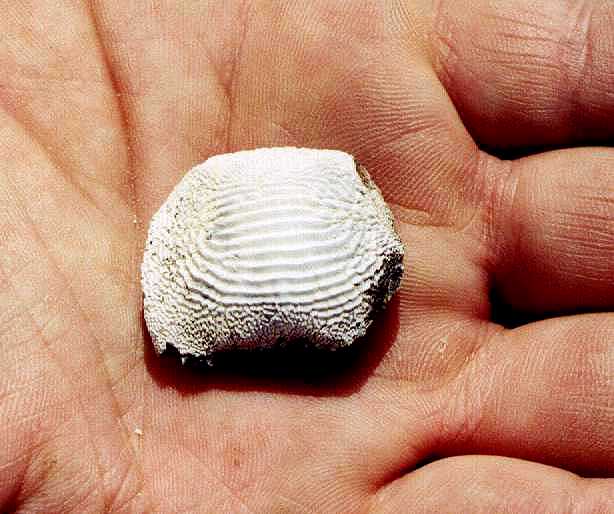
Ptychodontid Sharks:
Late Cretaceous Shell Crushers
Copyright © 2000-2013 by Mike Everhart
Last Revised 08/19/2013
A rare Ptychodus marginalis (FHSM VP-15008) tooth found by Tom Caggiano in southeast Gove County, KS, July, 1999
 |
Ptychodontid Sharks: Late Cretaceous Shell Crushers
Copyright © 2000-2013 by Mike EverhartLast Revised 08/19/2013
A rare Ptychodus marginalis (FHSM VP-15008) tooth found by Tom Caggiano in southeast Gove County, KS, July, 1999 |
The first illustration of a Ptychodus tooth (P. mortoni) was published by Morton (1834) but was not further identified than "The palate bones of a Fish?" The specimen was later sent to Dr. Mantell in England for identification. The tooth was later figured again and identified by Morton (1842), and noted to have been found by "Mr. Conrad in the older cretaceous strata at Prairie Bluff, Alabama." Manning (Pers. comm, 2002) indicated that is more likely that the tooth was from the Mooreville Chalk near Erie, Alabama. Although Morton was the first to publish the name, he did so without a description of the tooth. The species was officially described and named P. mortoni by Agassiz in 1843.
Gibbes (1848) published an illustration of a Ptychodus polygyrus tooth (below) in his "Monograph of the Fossil Squalidae of the United States." Leidy (1868) was the first to report on Ptychodus teeth from the "Cretaceous series" of western Kansas when he described a single, damaged tooth from "a few miles east of Fort Hays, Kansas." The tooth was obtained by Joseph LeConte during the survey for the Kansas Pacific Railroad in 1867. Leidy considered it to be a new species and named it Ptychodus occidentalis. Although the tooth was later lost from the collection of the Academy of Natural Sciences in Philadelphia (Spamer, et al., 1995), the figure of it shown in Leidy (1873, pl. 17 and 18) appears instead to be a marginal tooth of P. mortoni. Leidy (1873, pl. 18) also illustrates several P. mortoni teeth collected by Dr. George M. Sternberg while on military duty in western Kansas during the Indian wars of the late 1860s.
Cope (1874) listed four species of Ptychodus from Kansas, including a new species, P. janevaii, found by Mudge near Stockton, KS, and named in honor of Dr. John H. Janeway, Assistant Surgeon at Fort Hays; P. mortoni recovered by Mudge in the "Niobrara Cretaceous of the Smoky Hill River"; and P. occidentalis, Leidy 1868. The fourth species was Ptychodus polygyrus, found by Professors Mudge and Merrill in the "Niobrara epoch, Ellis County, Kansas." Unfortunately, except for the small P. occidentalis tooth described by Leidy (1868), there is no record of what became of these specimens. Professor B. F. Mudge (1877) also reported the discovery of 400 Ptychodus mortoni teeth "in an area of 30 inches, and apparently from the jaws of one individual."
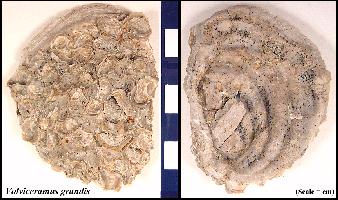 |
LEFT: So, what did ptychodontid sharks eat? While we are fairly sure
from their crushing type dentitions that they fed on hard shelled prey, we don't yet know
for certain what kinds of prey that included. While the general assumption has been that
these sharks fed on the many giant inoceramids in the Western Interior Sea, there is
little or no evidence to support this idea. Kauffman (1972) reported what appeared to be
ptychodontid tooth marks on a small clam shell and Hattin (1988) discussed damage to a Durania
maxima (rudist) specimen that he attributed to predation by a ptychodontid shark.
I think it's most likely that these durophagous sharks fed on the abundant and much
smaller juvenile inoceramids, like the one at left (2.5 by 2 in.) that would have been
readily available on the muddy sea floor. It would have been very difficult for most
ptychodontid sharks to crush the one inch-thick shell of an adult Volviceramus grandis.
Of course, a shark that is up to 20 feet long with a large mouth could eat about anything it wanted.... |
SYSTEMATIC PALEONTOLOGY Class Chondrichthyes Huxley, 1880 Subclass Elasmobranchii Bonaparte, 1838 Cohort Euselachii Hay, 1902 Subcohort Neoselachii Compagno 1977 Order incertae sedis Family Ptychodontidae Jaekel, 1898 Genus Ptychodus Agassiz, 1835 |
"Woodard (1887, p. 128) noted that the dentition of Ptychodus “is that of a true Ray, and does not bear the slightest resemblance to that of the Cestraciont Sharks.” While the Family Ptychodontidae has more recently been included in the Superfamily Hybodontoidea Zangerl, 1981 (Cappetta, 1987; Welton and Farish, 1993, and others), Stewart (1980) suggested that “…that all living sharks and rays (including Heterodontus) are members of the monophyletic Neoselachii, united by synapomorphies including the presence of calcified centra. Since Ptychodus shares this derived state, it must be regarded as a neoselachian and not as a hybodont …” Stewart’s conclusion was based on calcified centra found in a relatively complete specimen Ptychodus mortoni which is now in the University of Kansas collection (KUVP 59041). Cappetta (1987, p. 37) acknowledged Stewart’s comments, but noted that “it cannot be excluded that calcified centra appeared parallely in very specialized hybodonts like Ptychodus.” Unfortunately, KUVP 59041 has not been described further. Stewart’s (1980) suggestion is followed here while the authors note that additional refinement is necessary regarding the placement of the Family Ptychodontidae within the Neoselachii." (From Everhart and Caggiano 2004) |
A number of different specimens and species of Ptychodus are shown below. See also Sharks of Kansas:
 |
A nearly complete jaw plate of a very large Ptychodus mortoni (KUVP 55270) in the Natural History Museum at The University of Kansas (approximately 18 inches long by 10 inches wide). See another picture of this specimen HERE. This specimen was found by Professor E. S. Rose in the vicinity of Castle Rock in Trego County, sometime prior to 1900 (Williston, 1900). |
 |
The underside of an upper Ptychodus mortoni (FHSM VP-14785) jaw plate in situ, Smoky Hill Chalk, Gove County, Kansas. The scale is six inches. CLICK HERE to go to a webpage about Ptychodus mortoni and this specimen. The specimen is completely described in Shimada 2012. |
 |
The partially reconstructed upper jaw plate of a Ptychodus mortoni (FHSM VP-14785) showing the arrangement of tooth rows with the largest teeth the center row. |
 |
A portion of the same jaw plate shown above (FHSM VP-14785), with upper and lower views, and illustrating the symphysial tooth row on the underside, near the main center rows of the plate. Additional pictures, including close-ups are located HERE. |
 |
A nearly complete jaw plate of Ptychodus mortoni in the collection at the Sternberg Museum of Natural History. |
 |
A section of a rare and unusual ptychodontid jaw plate first described by Samuel Williston in 1898 (Plate XXVIII from Volume VI of The University Geological Survey of Kansas. He had named it Ptychodus martini (KUVP 55271). Apparently this species is not well recognized in recent literature, or has been assumed to be Ptychodus polygyrus. |
 |
This is a 1998 picture of Williston's Ptychodus martini type specimen (KUVP 55271: Scale = 6 in.) as curated in the Natural History Museum at The University of Kansas. Another, nearly complete jaw plate (probably only the second ever found) from a smaller individual was also discovered 1998, one hundred years after the publication of Williston's description of this species. |
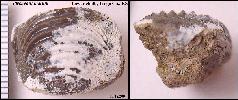 |
Occlusal and medial (?) views of a single tooth of Ptychodus martini found by Pam Everhart in the low chalk of Trego County (10/2004). The identification is based on the description provided by S.W. Williston, 1898. Recent photos of two other P. martini teeth are HERE and HERE (2007). |
 |
Four teeth from a recent discovery of more than 200 Ptychodus martini teeth in Gove County, KS, courtesy of Shawn Hamm. |
 |
An 'as found' picture of a rare Ptychodus polygyrus (FHSM VP-15008) tooth found in 1999 in Gove County, Kansas. This tooth is about the same size as those in the type specimen (above), and is the same tooth as shown at the top of the page. The picture of another Ptychodus sp. tooth (found a year later by the author) from the same area is located HERE. |
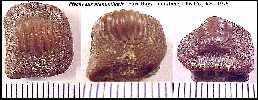 |
A single tooth of Ptychodus mammillaris from the lower
Fort Hays Limestone in Ellis Co., KS. See: Shimada, K. and M. J. Everhart. 2003. Ptychodus mammillaris (Elasmobranchii) and Enchodus cf. shumardi (Teleostei) from the Fort Hays Limestone Member of the Niobrara Chalk (Upper Cretaceous) in Ellis County, Kansas. Kansas Academy of Science, Transactions 106(3-4):171-176. |
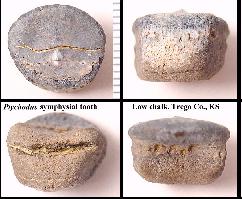 |
LEFT: An unusual looking Ptychodus tooth found in the lower chalk of Trego County by Keith Ewell (10/2004). While this might look like the tooth of an undescribed species of something else, it is actually one of the smaller 'symphysial' teeth that function as spacers between the two rows of large teeth in the upper jaw of a Ptychodus. |
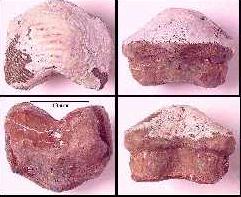 |
A second P. mammillaris tooth from southern Ellis
County (Fairport Chalk Member of the Carlile Shale). While it is likely that the species
occurs in Kansas, this is only the second P. mammillaris tooth to be documented.
See: Everhart, M. J. and M. K. Darnell. 2004. Occurrence of Ptychodus mammillaris (Elasmobranchii) in the Fairport Chalk Member of the Carlile Shale (Upper Cretaceous) of Ellis County, Kansas. Kansas Academy of Science, Transactions 107(3-4):126-130. |
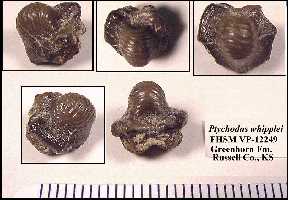 |
A single tooth of Ptychodus whipplei (FHSM VP-12249) from
the Greenhorn Fm. - below (older than) the Smoky Hill Chalk), Russell County, KS. More here.
Described and named by the French geologist Jules Marcou (1858, p. 33, Plate I, figs. 4, 4a) from a specimen he collected in Sante Fe County, New Mexico: "Tooth having the form of an obtuse rather square cone; the great folds of enamel arc confined to the apex of the tooth. and are quite worn away on the specimen figured; the body of the tooth is finely granulated; its height is considerable. and the edges of the base are ornamented with small irregular folds." "I
dedicate this beautiful species of cretaceous fish to my friend Capt. A.
W. Whipple, the able and learned chief of our Exploration in the Rocky Mountains." |
 |
A reconstructed lower jaw plate of Ptychodus polygyrus from the English Chalk (Photo provided bythe Monkton Field Study Centre, Monkton, East Kent, England). |
 |
The teeth of Ptychodus polygyrus and a drawing showing the placement of the teeth in the upper and lower jaw plates. published in an article by G. E. Dibley, 1911, Quarterly Journal, Geological Society, Vol. LXVII, pl. XVIII. (Provided by Ron Stilwell). |
 |
Ptychodus decurrens, P. dixoni and P. latissimus from the English Chalk, published in an article by G. E. Dibley, 1911, Quarterly Journal, Geological Society, Vol. LXVII, pl. XVIII. (Provided by Ron Stilwell) |
 |
The teeth of Ptychodus marginalis and Ptychodus polygyrus from A. S. Woodward in English Chalk Fishes, Palaeontographical Society, 1911. |
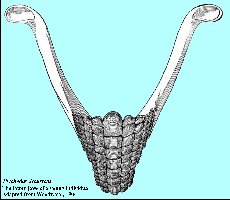 |
LEFT: The reconstruction of the lower jaw (Meckel's cartilages) of Ptychodus decurrens Agassiz, from Woodward, A.S. 1904. On the jaws of Ptychodus from the chalk. Quarterly Journal Geological Society London 60:133-136, 1 fig., pl. XV. Two specimens of P. decurrens from the Dakota Sandstone of Kansas are HERE and HERE |
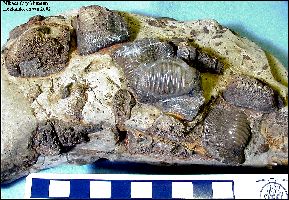 |
LEFT: A group of Ptychodus cf. mammillaris teeth from a concretion on the island of Hokkaido, Japan in the city museum at Mikasa. |
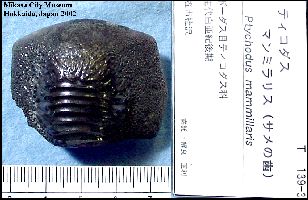 |
LEFT: A Ptychodus cf. mammillaris tooth in occlusal view in the city museum at Mikasa, Hokkaido, Japan (2004). |
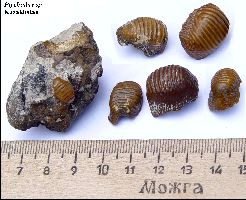 |
LEFT: Several crowns of Ptychodus sp. teeth from Kazakhstan. |
Read Tom Caggiano's story about finding a nearly complete Ptychodus anonymus in Kansas...and how it ended up in the American Museum of Natural History (now published as a paper: see Everhart and Caggiano 2004)
Ptychodus mortoni - A complete jaw plate from the Smoky Hill Chalk
Suggested references on Ptychodus in Kansas and around the world:
Agassiz, J. L. R. 1833-1844. Recherches sur les Poissons Fossiles. 3: pp. vii + 390 + 32, Neuchàtel and Soleure.
Applegate, S. P. 1970. The vertebrate fauna of the Selma Formation of Alabama; Part VIII, The Fishes. Fieldiana Geology Memoirs 3(8):383-433, text figs. 174-204.
Cappetta, H. 1973. Selachians from the Carlile Shale (Turonian) of South Dakota. Journal of Paleontology 47(3):504-514.
Cappetta, H. 1987. Chondrichthyes II - Mesozoic and Cenozoic Elasmobranchii. Gustav Fischer Verlag, Stuttgart and New York. 193 p., 148 fig.
Case, G. R. and D. R. Schwimmer. 1988. Late Cretaceous fish from the Blufftown Formation (Campanian) in western Georgia. Journal of Paleontology 62(2):290-301.
Case, G. R., T. T. Tokaryk and D. Baird. 1990. Selachians from the Niobrara Formation of the Upper Cretaceous (Coniacian) of Carrot River, Saskatchewan, Canada. Canadian Journal of Earth Sciences 27:1084-1094.
ON LINE: Cicimurri, D. 2001. Cretaceous elasmobranchs of the Greenhorn Formation (Middle Cenomanian-Middle Turonian), western South Dakota. p. 27-43 in V. L. Santucci and L. McClelland (eds.), Proceedings of the Sixth Fossil Resource Conference, Geologic Resources Division Technical Report, NPS/NRGRD/GRDTR-01/01.
Cicimurri, D. J. 2004. Late Cretaceous chondrichthyans from the Carlile Shale (Middle Turonian to Early Coniacian) of the Black Hills region, South Dakota and Wyoming. The Mountain Geologist 41(1):1-16.
Cope, E. D. 1874. Review of the Vertebrata of the Cretaceous period found west of the Mississippi River. U. S. Geological and Geographical Survey of the Territories, Bulletin 1(2):3-48.
Cope, E. D. 1875. The Vertebrata of the Cretaceous formations of the West. Report of the U. S. Geological Survey of the Territories (Hayden). 2:302 pp., 57 pls.
David, M.L. 1996. Dental histology of Ptychodus and its implications in the phylogeny of the Ptychodontidae, Journal of Vertebrate Paleontology 16(suppl. to 3):30A.
David, M.L. 1999. A histological and mechanical description of Ptychodus. M.S. thesis, Fort Hays State University, Hays, Kansas, 44 pp.
Dibley, G. E. 1911. On the teeth of Ptychodus and their distribution the English Chalk. Quarterly Journal of the Geological Society of London 67:263-277, pls. 17-22.
Dixon, F. 1850. Geology and fossils of the Tertiary and Cretaceous formations of Sussex. pp. i-xvi; 1-422. (New Edition, "revised and augmented" by Jones, T. R. 1878. William J. Smith, Brighton.
Everhart, M. J. 2003. First records of plesiosaurs from the lower Smoky Hill Chalk Member (Upper Coniacian) of the Niobrara Formation of western Kansas. Kansas Academy of Science, Transactions 106(3-4):139-148.
Everhart, M.J. 2013.The Palate Bones of a Fish?” – The First Specimen of Ptychodus mortoni (Chondrichthyes; Elasmobranchii) from Alabama. Bulletin of the Alabama Museum of Natural History 31(1):98-104.
Everhart, M. J. and Caggiano, T. 2004. An associated dentition and calcified vertebral centra of the Late Cretaceous elasmobranch, Ptychodus anonymus Williston 1900. Paludicola 4(4), p. 125-136.
Everhart, M. J., T. Caggiano, and K. Shimada. 2003. Note on the occurrence of five species of ptychodontid sharks from a single locality in the Smoky Hill Chalk (Late Cretaceous) of western Kansas. (Abstract) Kansas Academy of Science, Transactions 22:29.
Everhart, M. J. and Darnell. M.K. 2004. Occurrence of Ptychodus mammillaris (Elasmobranchii) in the Fairport Chalk Member of the Carlile Shale (Upper Cretaceous) of Ellis County, Kansas. Kansas Academy of Science, Transactions 107(3-4):126-130.
Evetts, M. J. 1979. Upper Cretaceous sharks from the Black Hills region, Wyoming and South Dakota. The Mountain Geologist, 16(2):59-66.
Gibbes, R.W. 1848-1850. Monograph of the fossil Squalidae of the
United States. Journal of the
Academy of Natural Sciences of Philadelphia, Volume 1, 2nd Series, Part. II,
Art. XII:139-147, Pls. 18-21; Part III, Art. XIV:191-206, Pls. 25-27; Part IV,
Art. XXV:299-300, Pl.42.
Hamm, S. A. and M. J. Everhart. 1999. The occurrence of a rare Ptychodid shark from the Smoky Hill Chalk (Upper Cretaceous) of western Kansas. Kansas Academy of Science, Transactions (Abstracts) 18:34.
Hamm, S. A. and K. Shimada. 2002. Associated tooth set of the Late Cretaceous lamniform shark, Scapanorhynchus raphiodon (Mitsukurinidae), from the Niobrara Chalk of western Kansas. Kansas Academy of Science, Transactions 105(1-2):18-26.
Hattin, D. E. 1982. Stratigraphy and depositional environment of the Smoky Hill Chalk Member, Niobrara Chalk (Upper Cretaceous) of the type area, western Kansas. Kansas Geological Survey Bulletin 225:108 pp.
Hattin, D. E., 1988. Rudists as historians; Smoky Hill Member of Niobrara Chalk (upper Cretaceous) of Kansas, Fort Hays Studies, Third Series, 10:4-22.
Herman, J. 1977. Les sélaciens des terrains néocrétacés et paléocenes de Belgique et des contrées limitrophes. Eléments d’une biostratigraphique inter-continentale. Mémoires pour sérvir a l'explication des Cartes géologiques et miniéres de la Belgique. Service Géoligique de Belgique, Mémoire 15, 401 pp.
Kauffman, E. G. 1972. Ptychodus predation upon a Cretaceous Inoceramus. Journal of Paleontology 15(3):439-444.
Leidy, J. 1868. Notice of American species of Ptychodus. Proceedings of the Academy of Natural Sciences of Philadelphia 20:205-208.
Leidy, J. 1873. Contributions to the extinct vertebrate fauna of the western territories. Report of the U.S. Geological Survey of the Territories (Hayden), 1:358 pp., 37 pls.
Lucas, S. G. 2002. The first vertebrate fossil described from New Mexico. New Mexico Geologist 24(2):49. (P. whipplei).
Lucas, S. G., B. S. Kues, S. N. Hayden, B. D. Allen, K. K. Kietzke, T. E. Williamson, P. Sealy, and R. Pence. 1988. Cretaceous stratigraphy and biostratigraphy, Cookes Range, Luna County, New Mexico. New Mexico Geological Society Guidebook, 39th Field Conference 143-167.
Mackie, S. J. 1863. Cestraciont fishes of the chalk. The Geologist 6: 161-163, pl. IX. (CM)
MacLeod, N. 1982. The first North American occurrence of the Late Cretaceous elasmobranch Ptychodus rugosus Dixon with comments on the functional morphology of the dentition and dermal denticles. Journal of Paleontology 56(2): 520-524.
MacLeod, N. and B. H. Slaughter. 1980. A new ptychodontid shark from the Upper Cretaceous of northeast Texas. The Texas Journal of Science 32(4):333-335.
Manning, E. M. and Dockery, D.T., III. 1992. A guide to the Frankstown vertebrate fossil locality (Upper Cretaceous), Prentiss County, Mississippi. Mississippi Department Environmental Quality, Office of Geology Circular 4:43 pp., 2 pl.
Marcou, J. 1858. Geology of North America. Zurich, 144 pp, Plates I-VII. (Ptychodus whipplei)
McNamara, K.J., Friend, D. and Long, J. A. 1993. A guide to the fossils of the Gingin Chalk. 2nd ed., Department of Earth and Planetary Sciences, Western Australian Museum , Perth
Meyer, R. L. 1974. Late Cretaceous elasmobranchs from the Mississippi and east Texas embayments of the Gulf Coastal Plain. Unpublished doctoral dissertation, Southern Methodist University, Dallas, 400pp.
Morton, S. G., 1834. Synopsis of the organic remains of the Cretaceous group of the United States. Key and Biddle, Philadelphia, 88 pp., 19 pl.
Morton, S. G. 1842. Description of some new species of organic remains of the Cretaceous group of the United States; with a tabular view of the fossils hitherto discovered in this formation. Journal of the Academy of Natural Sciences of Philadelphia. 8:207-227, 2 pl.
Mudge, B. F. 1876. Notes on the Tertiary and Cretaceous periods of Kansas. Bulletin of the U. S. Geological Survey of the Territories (Hayden), 2(3):211-221.
Nicholls, E. L. 1988. New material of Toxochelys latiremis Cope, and a revision of the genus Toxochelys (Testudines, Chelonoidea). Journal of Vertebrate Paleontology 8(2):181-187.
Parkin, J. A., K. Shimada, and B.A. Schumacher. 2002. Fossil fishes from the lowermost Greenhorn Limestone (Upper Cretaceous: Middle Cenomanian) in southeastern Colorado. Paper No. 187-15, Geological Society of American Annual Meeting.
Schwimmer, D. R., J. D. Stewart and G. D. Williams. 1997. Scavenging by sharks of the genus Squalicorax in the Late Cretaceous of North America. Palaios 12:71-83.
Shimada, K. 1993. Upper Cretaceous elasmobranchs from the Blue Hill Shale Member of the Carlile Shale, Western Kansas. Kansas Academy of Science, Transactions 12(78).
Shimada, K. 1996. Selachians from the Fort Hays Limestone Member of the Niobrara Chalk (Upper Cretaceous), Ellis County, Kansas. Kansas Academy of Science, Transactions 99(1-2):1-15.
Shimada, K. 2012. Dentition of Late Cretaceous shark, Ptychodus mortoni (Elasmobranchii, Ptychodontidae). Journal of Vertebrate Paleontology 32:6:1271-1284.
Shimada, K. and Everhart, M.J. 2003. Ptychodus mammillaris (Elasmobranchii) and Enchodus cf. shumardi (Teleostei) from the Fort Hays Limestone Member of the Niobrara Chalk (Upper Cretaceous) in Ellis County, Kansas. Kansas Academy of Science, Transactions 106(3-4):171-176.
Shimada, K.,
Everhart, M.J., Decker, R. and Decker P.D. 2010. A new skeletal remain of the
durophagous shark, Ptychodus mortoni, from the Upper Cretaceous of
Shimada, K. and D. J. Martin. 1993. Upper Cretaceous selachians from the basal Greenhorn Limestone in Russell Co., Kansas. Kansas Academy of Science, Transactions 12:78.
Siverson, M., 1999. A new large lamniform shark from the uppermost Gearle Siltstone (Cenomanian, Late Cretaceous) of Western Australia. Transactions of the Royal Society of Edinburgh: Earth Sciences, 90:49-66. (Ptychodus decurrens in Australia)
Skelton, L. H. 1996. A brief history of the Kansas Academy of Science. Kansas Academy of Science, Transactions 101(3-4):140-145.
Stewart, J.D. 1980. Reevaluation of the phylogenetic position of the Ptychodontidae. Abstracts of Papers, Kansas Academy of Science, Transactions 83(3):154.
Stewart, J.D. 1988. Paleoecology and the first North American west coast record of the shark genus Ptychodus. Journal of Vertebrate Paleontology, 8:27A.
Stewart, J.D. 1990. Niobrara Formation vertebrate stratigraphy. Pages 19-30, in S. C. Bennett, (ed.), Niobrara Chalk Excursion Guidebook. University of Kansas Museum of Natural History and Kansas Geological Survey.
Welton, B. J. and R. F. Farish. 1993. The collectors guide to fossil sharks and rays from the Cretaceous of Texas. Horton Printing Company, Dallas, 204 pp.
Williamson, T. E., J. I. Kirkland and S G. Lucas. 1993. Selachians from the Greenhorn cyclothem ("Middle" Cretaceous: Cenomanian-Turonian), Black Mesa, Arizona, and the paleogeographic distribution of Late Cretaceous selachians. Journal of Paleontology 67(3):447-474.
Williamson, T.E., S. G. Lucas and J. I. Kirkland. 1990. The Cretaceous elasmobranch Ptychodus decurrens Agassiz from North America. Geobios 24(5):595-599.
Williston, S.W. 1900. Some fish teeth from the Kansas Cretaceous. Kansas University Quarterly 9(1): 27-42, pl. VI-XIV.
Williston, S.W. 1900. Cretaceous fishes [of Kansas]. Selachians and Pycnodonts. University Geological Survey Kansas VI pp. 237-256, with pls. Read online
Woodward, A. S. 1887. On the dentition and affinities of the selachian genus Ptychodus Agassiz. Quarterly Journal of the Geological Society 43:121-131, 1 pl.
Woodward, A.S. 1904. On the jaws of Ptychodus from the chalk. Quarterly Journal Geological Society London 60:133-136, 1 fig., pl. XV.